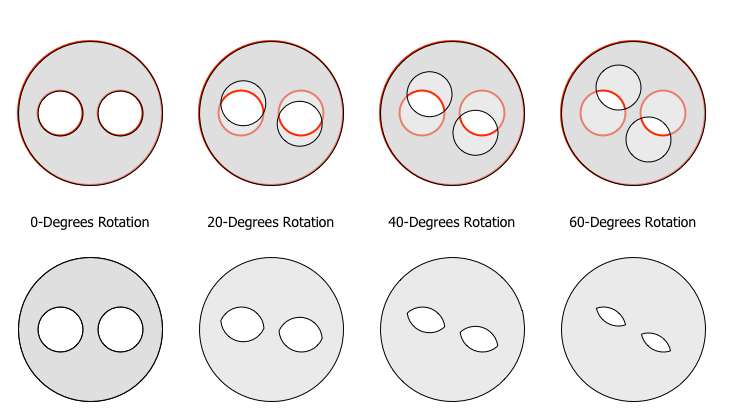Choke Valve
Choke Valves are valves used in severe service valves designed for oil and gas applications. They are used for controlling the flow rates or pressure on production, steam or water injection. Choke Valves are subjected extreme conditions which can cause erosion, corrosion and other damage. When used on controlling production flowback, solids that are found in the well bore may come up with the production fluids. Additionally, entrained gas may flash across the choke causing cavitation of the valve. For high differential pressure (DP) applications, the velocity through the valve may be very high causing erosion of the internal components.
Chokes can be adjustable or non-adjustable based on the valve design. Adjustable chokes can have a very high turndown to cover a very wide range of flow rates or pressure differentials. An example of an adjustable choke profile is below. There are two disks that sit on top of each other. When the valve is completely open, holes in the disk are perfectly aligned, letting the fluid pass through relatively unobstructed. As the valve is turned, the upper disk is rotated causing the flow path to get smaller. As the holes get smaller, the velocity through the disks increases. Downstream of these disks will subject to extreme conditions of high velocity flow rates and cavitation in the valve.
 Equipment Multi Orifice Choke Profile - Click to Enlarge
Equipment Multi Orifice Choke Profile - Click to Enlarge
Non-adjustable chokes typically have a piece of metal inthe choke, called a 'bean' which is designed to a specific flow rate and DP. A bean is a rod with a set diameter that decreases the flow area through the valve which affects the pressure drop. Like any non-adjustable control valve, using a bean choke is best served in applications that have very little fluctuation in upstream flow and pressure.
Choke Valve Design Considerations
Corrosion - As with any valve, pipe or fitting, the selection of materials must be compatible with the fluid flowing through it. When specifying a choke valve, ensure that the body, trim, seals and other internal components are appropriate for the process stream.
Erosion - In order to cause pressure drop across the choke, the orifice through which the fluid flows will experience very high velocities. The point of highest velocities is called the vena contracta. This is the point where the flow area is the smallest and the velocity is the highest. In addition to this, the process stream may contain sand, silica or other elements that decrease the valve's resistance to erosion. When specifying a choke valve, it is important to take this into consideration. Many choke valves have materials of increased hardness like tungsten carbide or 17-4 PH Stainless Steel that have excellent wear resistance. However, there is a trade off in that very high hardness materials are often very brittle.
Cavitation - Cavitation occurs immediately downstream of the vena contracta when the flowing velocity suddenly slows. This is extremelly hard on the valve and instances of high cavitation can cause damage to erosion resistant metals, like those mentioned above. Damage caused by cavitation can destroy the valve and/ or the piping downstream of the valve. Failure can be sudden and catastrophic. Flow that is cavitating will sound like a hiss or rattle that increases as cavitation increases.

